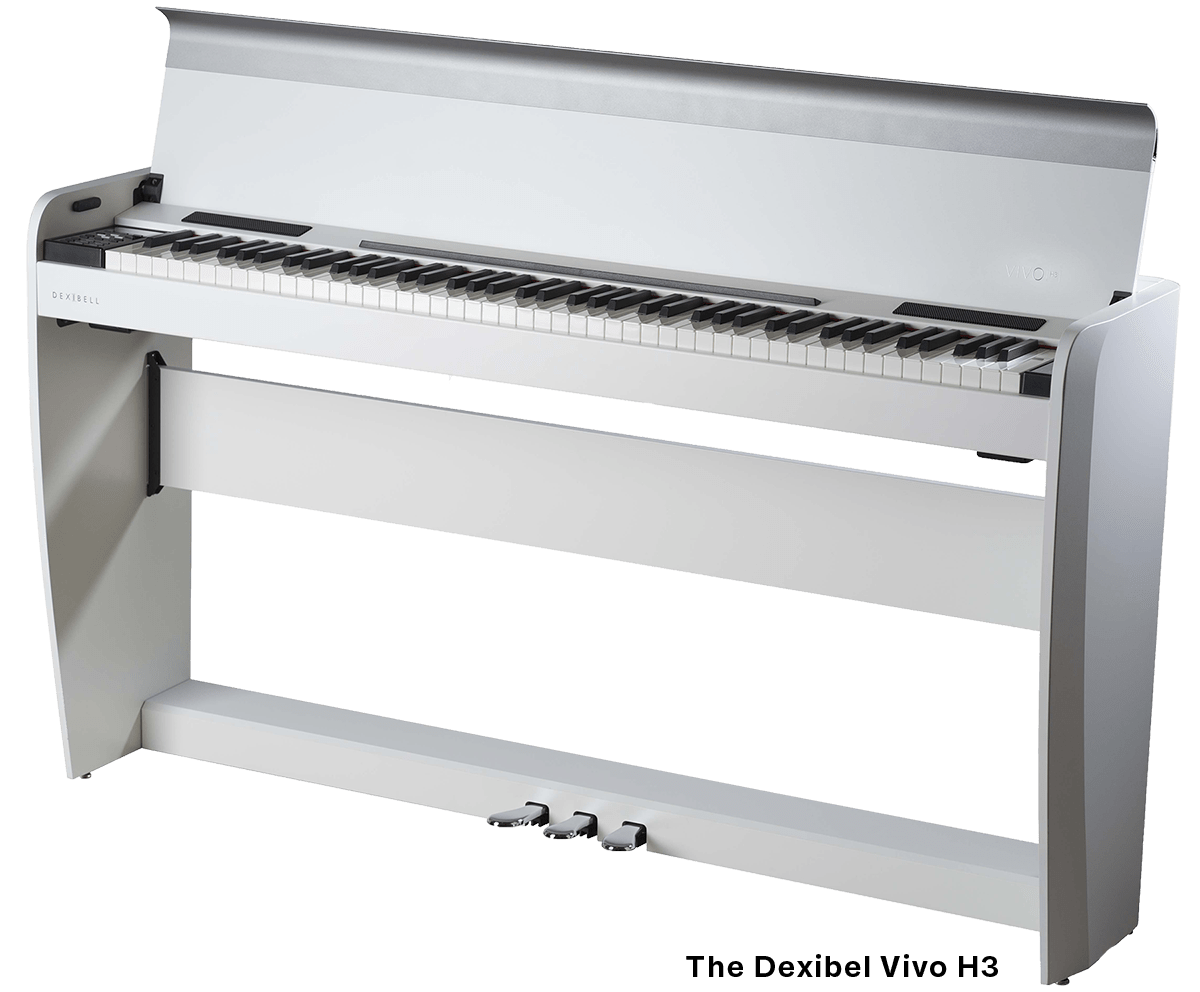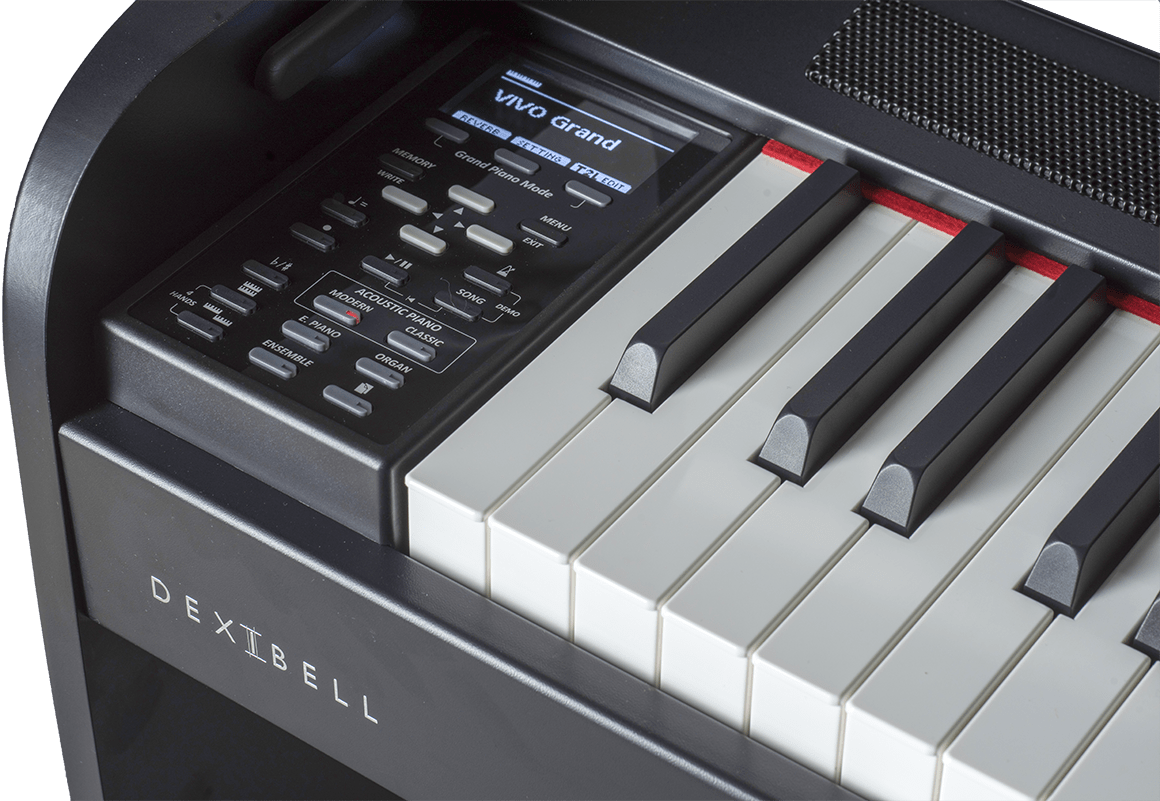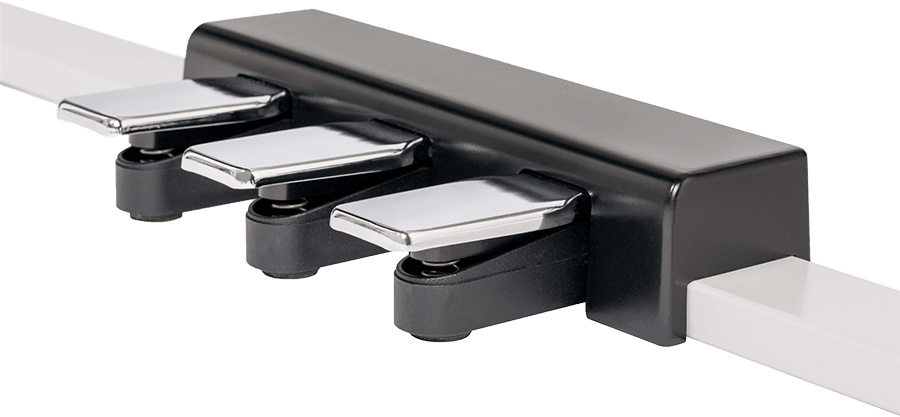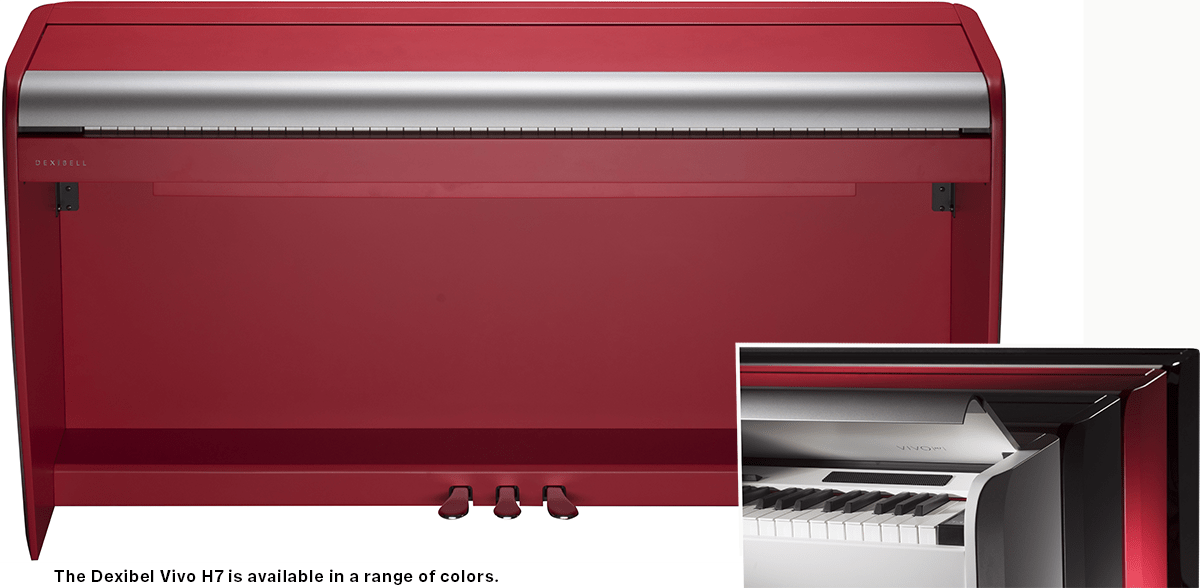Dexibell was established in 2013 by the R&D and engineering team of the former Roland Europe, with financial backing from parent company Proel S.p.A., an Italian manufacturer of leading brands of professional audio and lighting equipment, musical instruments, and accessories. In 2017, after several years of international success, Proel began distributing the Dexibell brand in North America.

The Vivo series comprises three types of models: Portable (slab with internal speakers), Stage (slab without speakers), and Home (vertical or console style with internal speakers). The Vivo Home Series is available in three models: H1, H3, and H7. All use the same sound engine, but differ in the number and power of speakers and amplifiers, type of keyboard and action, whether or not they include Bluetooth, and sophistication and color of cabinetry. Dexibell partnered with Ferrari’s design firm to create a look for its instruments that is uniquely Italian, including striking color options, such as black, white, red, pink, green, orange, and blue, in matte and polished finishes. For this review, we were sent an H3 in classic but boring matte black.
The Vivos feature a logical, intuitive user interface: power button and volume knob on the right side of the keyboard, display and control buttons on the left. The display is OLED rather than the more common (on digital pianos) LED. An LED display requires backlighting, but in an OLED display, the pixels produce their own light. This sharpens the contrast, and makes the text and graphics easier to read in a wide variety of lighting conditions.

The menu system, too, is logically organized—it was easy to find the most common functions, usually without having to consult the user’s manual. It was also simple to navigate the H3’s 79 excellent sounds, activate the metronome, and adjust the tempo, and equally easy to split the keyboard to play one sound in the right half and another in the left, or to layer two sounds across the entire keyboard. The ability to create four-hand mode—splitting the keyboard at about middle C into two 44-note keyboards, each with an independent headphone output and its own damper pedal—will come as a boon to those who teach group piano lessons and, for space or economic reasons, need to double up.
The H1 and H3 feature Fatar TP-100LR hammer-action keyboards, while the H7 has a Fatar TP-40GH graded hammer action that’s heavier in the bass and lighter in the treble, as in an acoustic piano. The H7 keys also have keytops of an ivory-like synthetic material for better grip and touch. Although my H3 review sample lacked the hammer grading and ivory feel, its action felt similar to that of a comfortably “played-in” acoustic piano, neither too heavy nor too light, and was easy to grow accustomed to with only a few minutes’ playing.
Vivo models conveniently have two stereo headphone jacks, ⅛" and ¼", just under the left side of the keyboard. The jacks are set back just far enough from the front to prevent accidental damage to them if an attached headphone plug is bumped. A stereo ⅛" jack is also provided here, for easy input of an audio signal from an external source such as a mobile device. Under the right side of the keyboard are two USB ports, one for connecting a flash drive to add sounds, the other for sending MIDI via USB for a variety of other functions. Two downward-facing ¼" audio outputs are on the underside of the keybed instead of at the rear of the instrument, to allow the H3 to be positioned close to a wall even with audio cables connected.

All three Home models have three pedals. The damper and soft pedals both feature progressive action, to permit half-pedaling. The H1’s pedals are attached to a fairly thin board along the bottom of the stand, and the stand itself has no horizontal crosspiece at the top. The H3 adds a thicker, sturdier, multi-piece board at the bottom and a horizontal crosspiece near the top; the H7’s stand has a fully enclosed back. The stands, made of MDF, are sleekly attractive but stable, and all three models have a soft-close fallboard (keyboard lid) of MDF with an attractively curved metal edge. When open, the fallboard becomes the music desk. Books stood nicely on this desk, but the fallboard’s curved edge bent sheet music forward, where it settled into a concave shape. Placing a thin book behind the sheet music easily solved this.
The H1 has two full-range speakers driven by two 35-watt amplifiers; the H3 contains two woofers and two tweeters, driven by two 35-watt amps; and the H7 has two larger woofers, two tweeters, and an 8" subwoofer, driven by two 56-watt amplifiers. The H3 review sample also came with a pair of Dexibell’s own DX HF7 closed-back headphones. I found these very comfortable to wear for long periods, and their sound was excellent, balanced and clear. The headphone cable is both thick and removable, which means it’s unlikely to short out; if it does, it’s easily replaced. Coiled and straight cables are provided, to suit the user’s preference.
The Vivo series makes use of Dexibell’s proprietary method of sound re-creation, True to Life (T2L). A hybrid technology, T2L pairs two types of sound re-creation: sampling and physical modeling. The primary method of sound re-creation is sampling: PCM recordings are made of every note of various acoustic pianos, and those recordings are played back as the performer depresses the keys. Typically, for digital pianos, these recordings are made at the Compact Disc’s standard resolution of 16-bit/44.1kHz, or 16/44.1. However, Dexibell has raised the bar by creating 24-bit/48kHz recordings, the equivalent of DVD-quality audio.

Because PCM samples consume great amounts of memory storage, most digital-piano makers use a variety of techniques to shorten them—most commonly, by looping (i.e., repeating) the recording as the sound fades out, which means that a shorter original recording can be stored. The problem with this technique is that, on an acoustic piano, the volume of the harmonics produced by each string varies over time, causing subtle but noticeable changes in timbre as the sound decays. With many digital pianos, however, as a short, recorded loop repeats over and over, the note’s harmonics never get a chance to decay naturally, and the realism of the sound is quickly lost. The Vivo series employs much longer samples—up to 15 seconds—before the sample begins to loop. Given the 15-second sample length, most sounds will never reach the end of the original sample; thus, the sound’s realism will be maintained. These longer samples are especially important for lower notes, in which the frequencies of the harmonics are spread further apart, making any discrepancies in them more easily audible.
Vivo samples also make use of a type of binaural recording called Holophonics. Holophonic recordings are typically made using two microphones positioned in the general location of the ears on a human head, with a solid barrier between them to re-create the way sounds heard directly in the ear closer to the source of the sound are partially blocked by the head before they can be heard, a fraction of a second later, in the other ear. This is how the human ear/brain system actually works, and it’s how we can usually tell which direction a sound is coming from. Such recordings effectively create an “audio hologram.” The effect of the Holophonic recording process was readily apparent when I played the Vivo Home H3: The sound seemed to have greater depth of field and realism than I would have expected from a digital instrument. The sound was more immediate, and seemed to come from directions other than the Vivo’s speakers, as if there were an actual acoustic piano in the room as opposed to a recording of one. The effect was not unpleasantly artificial or obnoxiously overdone, but perfectly complemented the H3’s already excellent sound.
The other technique the Vivos use to produce sound is physical modeling (or just modeling, as Dexibell calls it), in which a mathematical algorithm models the vibrations of a sound-producing physical object such as a string, or the resonant qualities of the soundboard or case of a grand piano. One quality that gives acoustic pianos their characteristic sound is the sympathetic vibration of the unplayed strings, as is audible when the sustain pedal is depressed. Attempting to re-create this behavior with sampling would be nearly impossible—multiple sympathetic frequencies can be created in the same strings by different notes, and recording each of these frequencies for each key would require not only huge amounts of sample memory, but also an extremely complex sample-selection system that would play back just the right recordings for a specific combination of pressed keys. Physical modeling greatly simplifies the re-creation of these sympathetic vibrations. The subtle addition of these physically modeled resonances and sympathetic vibrations to the Vivo’s already great sampled sounds brings a whole new level of realism to the experience of playing these instruments. The Vivo pianos also allow performers to silently hold down keys for a re-creation of the sympathetic vibrations caused by other keys, just as you would on an acoustic instrument.
Dexibell’s attention to realistic sound doesn’t end with high-quality samples, long sample times, and physically modeled string resonances. The Vivo-series pianos also feature sample recordings of the mechanical noises unique to the included instruments. The Vivo Editor app lets users control the amounts of hammer and key-release noise, the sounds of the damper pedal being engaged and released, and the level of the modeled sympathetic resonances of acoustic-piano sounds. For electric-piano sounds, the amounts of tine noise, cabinet resonance, and growl can all be adjusted, as can the level of jack-return noise for such historic instruments as the harpsichord and clavichord. Tonewheel organ sounds permit control of percussion sounds, and for many sounds, the envelope (a graph of the changes in sound over time) can be adjusted to the user’s preferences using standard envelope-generator software, to control parameters such as attack, hold, decay, sustain, and release.
One might worry that so much flexibility might result in unwieldy complexity in the user interface, but most menus are only a page or two deep and easy to navigate. Better still, Dexibell offers the Vivo Editor app for the Apple iPad at no charge in the Apple App Store. You’ll need Apple’s Lightning to USB Camera Adapter ($29, not included) to connect your iPad to the Vivo. That done, it’s easy to access most of the sound controls via the larger touchscreen of an iPad.
The Vivo Home H3 and H7 offer Bluetooth connectivity, and it was easy to pair an iPad with the Vivo and stream music wirelessly via Bluetooth from iTunes to the Vivo’s speakers. However, the Bluetooth connectivity doesn’t extend to the Vivo Editor app: a USB connection with the camera-connection kit is required. Bluetooth also doesn’t work for streaming music via Dexibell’s free Xmure app, which provides auto-accompaniment features, as well as the ability to create “musical selfies” (combined audio/video recordings of user performances). Using Xmure requires connecting the iPad’s headphone jack to the Vivo’s ⅛" audio input jack with a stereo cable. The Vivo’s audio input and USB connectors are at opposite ends of the keyboard, and the headphone and Lightning connectors on iPad Smart Covers are on opposite sides of the cover, oriented contrary to the Vivo’s connectors—the resulting cabling is, to say the least, less than elegant. It seems odd that in an instrument otherwise so intuitively designed, an opportunity for completely wireless connectivity, as some of its competitors have implemented, has been missed.
However, these minor issues have no bearing on playing the instrument without an iPad, and here the Vivo really shone—after all, if an instrument doesn’t sound great, all the innovations in the world mean nothing. It was truly a joy to play the Vivo H3; its sound was expressive, its touch responsive. The included sounds range from acoustic and electric pianos to electric and pipe organs, and include harpsichords, clavichords, and mallet instruments. A nice selection of strings and pads is available for layering with keyboard sounds, and the selection of bass sounds covers just about all styles, with a few guitar sounds to boot. Additional sounds in the Sound Font format can be downloaded from the Internet, saved to a flash drive, and imported. Dexibell provides a sizable number of these additional sounds free of charge to registered users, and the process of importing them was painless after just a few minutes of figuring it out. When switching sounds, the Vivo lets you sustain notes with one sound even after you’ve switched to another sound—an important feature for performing musicians.
Dexibell has achieved great musical success with the Vivo Home series of digital pianos, creating instruments that sound terrific, look smart, and are rewarding to play. They would make a fine choice for anyone looking for a digital piano for home or teaching-studio use.
Watch Sam Ecoff’s videos explaining the features and operation of the Dexibell Vivo Home H3 Digital Piano.
DEXIBELL HOME SERIES SPECIFICATIONS
| |
H1 |
H3 |
H7 |
| Keyboard & Action |
88 notes
weighted
triple contact |
88 notes
weighted
triple contact |
88 notes
weighted, graded
ivory feel
triple contact |
| Pedals |
3 incl. half-pedaling |
3 incl. half-pedaling |
3 incl. half-pedaling |
| Voices |
79 |
79 |
79 |
| Sound Source |
Sampling/Modeling |
Sampling/Modeling |
Sampling/Modeling |
| Polyphony |
Unlimited |
Unlimited |
Unlimited |
| Speakers |
2 |
4 |
5 |
| Amplification |
70 watts |
70 watts |
112 watts |
| Bluetooth |
No |
Yes |
Yes |
| External Storage |
USB |
USB |
USB |
| USB to Computer |
Yes |
Yes |
Yes |
| USB Digital Audio |
Yes |
Yes |
Yes |
| Dimensions WxDxH (in.) |
56x14x31 |
56x14x31 |
56x14x31 |
| Weight (lbs.) |
99 |
97 |
137 |
| Price (US$) |
$2,499 |
$2,799 |
$4,199 |